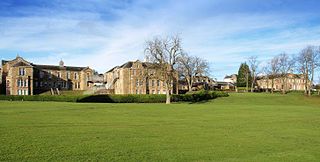
Stratheden is a hamlet 2 miles west of Cupar, and just north of Springfield, in Fife, Scotland.
Kingsbarns is a village and parish in Scotland lies near the eastern coast of Fife, in an area known as the East Neuk, 6.5 miles (10.5 km) southeast of St Andrews and 3.6 miles (5.8 km) north of Crail. The name derives from the area being the location of the barns used to store grain before being transported to the Palace at Falkland.

Newhouse is a hamlet and major road interchange located in North Lanarkshire, Scotland, sited immediately east of the Eurocentral industrial park, two miles west of the village of Salsburgh, 1.8 miles (2.9 km) east of Holytown and about 4 miles (6.4 km) north east of Motherwell.
Abercrombie is a village in Fife, Scotland.

The River Eden is a river in Fife in Scotland, and is one of Fife's two principal rivers, along with the Leven. It is nearly 30 miles (48 km) long and has a fall of around 300 feet (91 m).

The Bunnet Stane is a rock formation near the hamlet of Gateside in Fife, at the foot of West Lomond. It sits upon one of the calciferous sandstone outcrops of the Old Red Sandstone suie that exist around the base of the Lomond Hills. The Bunnet Stane itself consists of an elevated table of rock, about ten feet by twenty feet across, which sits upon a thin column of rock like a giant mushroom. There are several romantic explanations for the stone's shape, but it was formed entirely by the natural weathering of the exposed outcrop.
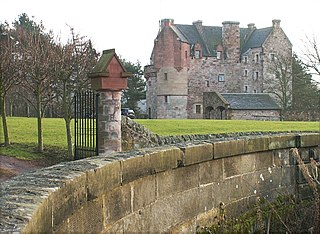
Dairsie, or Osnaburgh, is a village and parish in north-east Fife, Scotland. It is 3 miles (4.8 km) south-southwest of Leuchars Junction, and 3 miles (4.8 km) east-northeast of Cupar on the A91 Stirling to St Andrews road. The village grew out of two smaller settlements, and developed principally around the industry of weaving. Since the late twentieth century it has become a dormitory settlement for nearby towns.
The hamlet of Auchentiber is in North Ayrshire, Parish of Kilwinning, Scotland. Auchentiber is four miles northeast of Kilwinning on the Lochlibo Road, 2+1⁄4 mi (3.5 km) from the hamlet of Burnhouse and 2+1⁄2 mi (4 km) from the village of Barrmill. Grid Ref. NS3647. Some new housing has been built, but the settlement is still very much a hamlet. The settlement is on the Lugton Water, which runs into the River Garnock after running through Montgreenan and Eglinton Country Park in Irvine.
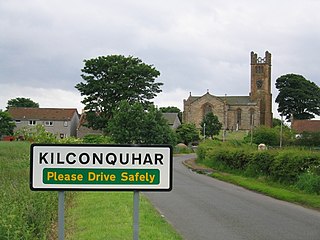
Kilconquhar is a village and parish in Fife in Scotland. It includes the small hamlet of Barnyards. It is bounded by the parishes of Elie, Ceres, Cameron, St Monans, Carnbee, Newburn and Largo. It is approximately 9 miles from north to south. Much of the land is agricultural or wooded. The village itself is situated inland, north of Kilconquhar Loch. Also in the civil parish are Colinsburgh and Largoward, the latter since 1860 being a separate ecclesiastical parish.

Inchmoan is an island in Loch Lomond, Scotland.
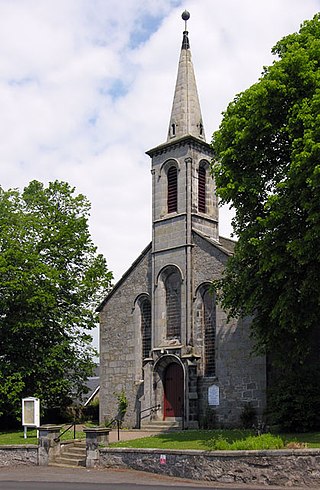
Carnock is a village and parish of Fife, Scotland, 4+1⁄4 miles west of Dunfermline. It is 1+1⁄4 miles east of Oakley, Fife. The name of the village derives from Scottish Gaelic, from ceàrn ("corner"), with a suffix denoting a toponym, thus giving "[the] corner place". Carnock is known to have had military significance in antiquity. The civil parish had a population of 5,927 as of 2011.
Cameron Bridge is a village in the conurbation of Levenmouth in Fife, Scotland. It is near to the village of Windygates and 2 miles west of the town of Leven. A distillery was established in the 19th century by the Haig family, which is now part of Diageo. The distillery produces Scotch whisky.
Bonnybank is a small village in the Levenmouth area of Fife, approximately 2 miles north of Leven and situated on the main road between Kennoway and Cupar. It boasts a popular Mexican restaurant, the Bonnybank Inn. The population make-up is vastly white (99%), with an even split between males and females.

Glenapp Castle, formerly the family seat of the Earl of Inchcape, is now a luxury hotel and restaurant located about 1+1⁄2 miles southeast of Ballantrae, South Ayrshire, Scotland.
Creich, is a hamlet in Fife, Scotland.

Pitscottie is a village in the Parish of Ceres, Fife, situated on the Ceres Burn at a road junction to the south of Dura Den and 3 miles (5 km) southeast of Cupar. The nearby Pitscottie Moor was a favourite meeting place of Covenanters during the late 17th century and during the 1820s the village became a centre of flax spinning. There is an 18th-century bridge over the Ceres Burn.
Logie is a parish and village in east Fife, Scotland, 5 miles north-east of Cupar.
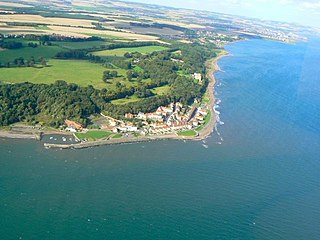
Wemyss is a civil parish on the south coast of Fife, Scotland, lying on the Firth of Forth. It is bounded on the north-east by the parish of Scoonie and the south-west by the parish of Kirkcaldy and Dysart and its length from south-west to north-east is about 6 miles. Inland it is bounded by Markinch and its greatest breadth is 2+1⁄4 miles.
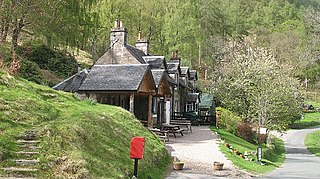
Bridge of Balgie is a hamlet in Glen Lyon and lies at the junction between the east–west single track road along the foot of the glen from Fortingall to Loch Lyon and the unclassified mountain road running over the western shoulder of Ben Lawers to the A827 near Milton Morenish on the shores of Loch Tay. Although it only comprises a few dwellings, it is the principal settlement in the central section of Glen Lyon and contains a combined post office and tea room which is popular with walkers and other visitors.
The Riggin o Fife is an upland area of Fife, Scotland which runs eastward from the Markinch Gap and the Howe of Fife to form the elevated hinterland to the coastal villages of the East Neuk. At 290 m, Largo Law is the highest hill, with other high points including Clatto Hill, Drumcarrow Craig, Flagstaff Hill, Kellie Law and Hill of Tarvit. The area is rural, populated by farms and hamlets, with a few small villages, such as Largoward and Peat Inn.












